On View
Zeng Fanzhi and Philip Tinari Have Big Plans for Beijing
See what the in-demand artist has to say about his work.
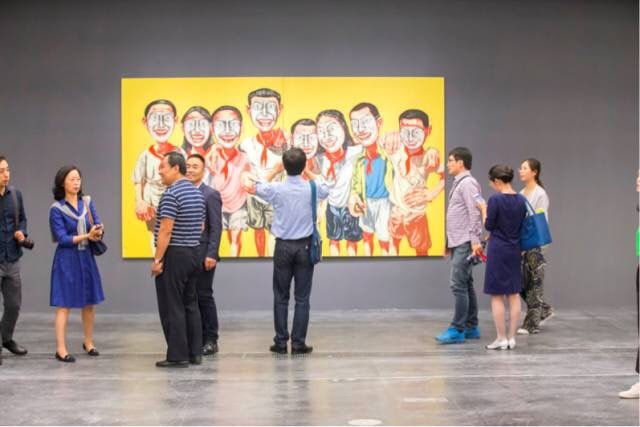
See what the in-demand artist has to say about his work.

Xavier Liang

After the opening of his solo exhibition “Parcours” at Ullens Center for Contemporary Art (UCCA) in Beijing in September, what artist Zeng Fanzhi has done most frequently is go into the dark room at the end of the exhibition space, asking his assistants to adjust the lights according to audience’s responses. This no-photos-allowed room gives an intimate glimpse at the Chinese artist’s latest ink on paper works.
The series took six years to make, and the artist even participated in the process of making the paper on which they are painted. Walking through a pitch-black aisle leading to that low-lit space, the audience will be exposed to another side of Zeng, who is on artnet’s list of 100 most collectible artists again this year.
Rather than his usual portraits, his new paintings focus on naturalistic scenes, and are filled with floating clouds, mountains, and rocks, as well as waterfalls. The painting does not cover, but makes visible, the natural textures of the paper, which Zeng sees as “naturally formed”. As patient as an archaeologist, he discreetly “excavates” these images within the paper, with the touch of a brush.

Exhibition view of “Zeng Fanzhi: Parcours”. Courtesy: © Zeng Fanzhi Studio
Zeng was nervous before the opening, and was yearning to know the reactions from the audience. “Actually I’m still very excited now,” Zeng told me right before the interview. “The feedback is quite positive, but there is also some criticism, which is good, too.”
artnet News sat down with the artist and UCCA director Philip Tinari, to get a sense of where Zeng’s work is headed. (Translation by Elaine Tan.)
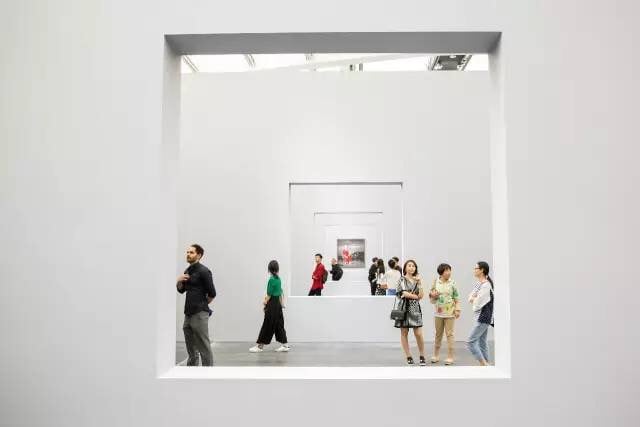
Exhibition view of “Zeng Fanzhi: Parcours”. Courtesy: © Zeng Fanzhi Studio.
The renowned Japanese architect Tadao Ando designed the exhibition space. What was that collaboration like?
Zeng: It is always interesting to see the collaborative result between artists and architects. First of all, the architect has to know about the space and understands the artist well, from which he could start thinking of the details through his perspectives. The collaboration has to be established on abundant communications and understandings, and there has to be “chemistry” between the two. When an architect encounters a space like UCCA that is full of possibilities, his creative desire will be inspired for sure.
Tinari: Speaking from the institutional perspective, the “emptiness” of UCCA’s main exhibition space requires design and redesign specifically for each exhibition. Several of our most successful shows have originated from collaborations between artists and designers. For instances, William Kentridge chose to work with his long-time collaborator Sabine Theunissen, who designs the sets for all of his opera projects, while David Diao teamed up with Christian Bjone, an architect who was apprenticed to Philip Johnson due to his interest in modernism.
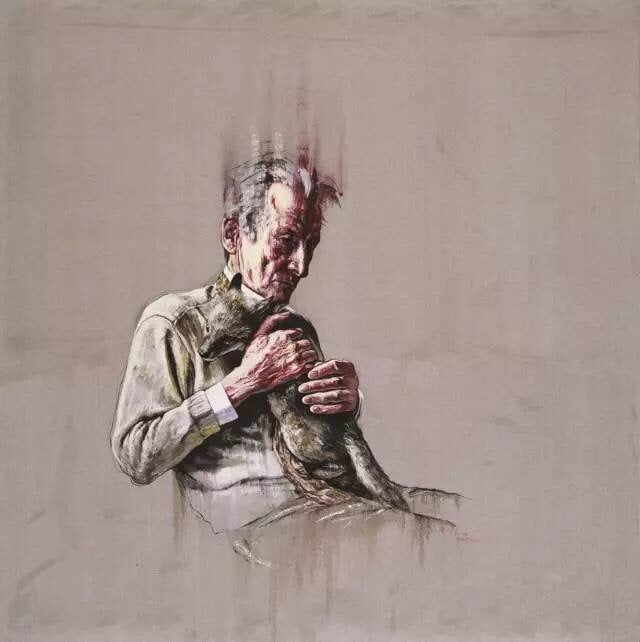
Zeng Fanzhi, Lucian Freud (2011). Courtesy: © Zeng Fanzhi Studio.
You have been mounting a number of artists’ retrospectives, from Gu Dexin, Wang Xingwei, William Kentridge and David Diao, to this exhibit. Could you talk a bit about your curatorial approach?
Tinari: We are living in a world where knowledge often comes in fragments. We used to think that one can hardly have an overall understanding or recognition of contemporary art or art history unless he/she is trained with a systematic art education, but on the other hand, there are so many non-specialists interested in art. Since UCCA is an institution open to the public, and that hopefully serves to educate the public, or allow the public to educate itself, we feel it is better to present several dimensions of one artist than merely display one aspect of the artist. When organizing this kind of “multi-dimensional” exhibition, we try to arrive at an inclusive understanding and judgment towards the artist. If those aforementioned exhibitions did succeed, it probably could be attributed to our persistence.
Talking about the “Parcours” exhibition, I don’t think Zeng would admit that this is a “retrospective”, which he thinks is too big a word for him now. But what we tried to do here is to sort out the threads and relations among different series and periods, and to a large extent we did this through the exhibition design—you can see a range of works from several moments from basically any angle in the gallery, and the audience are able to discover the logic of his work through their visual experiences.
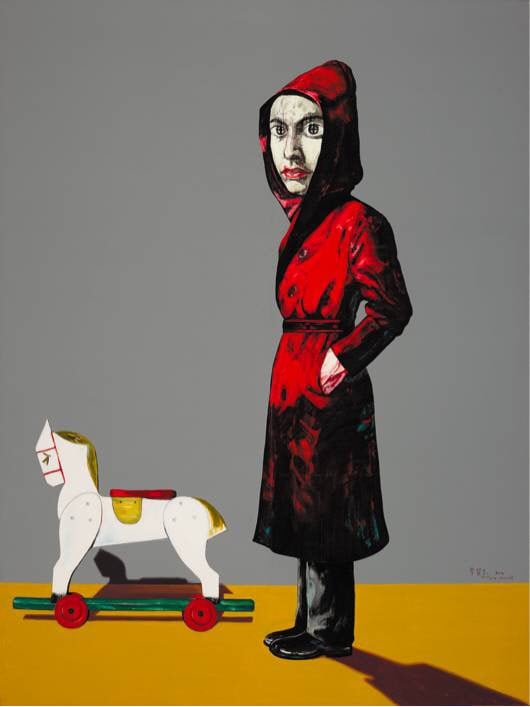
Zeng Fanzhi, Portrait (2004). Courtesy: © Zeng Fanzhi Studio.
After these years, what are your impressions of Zeng?
Tinari: What seems to the most intriguing is he always surprises you. I remember being in Miami back in 2006, when Lorenz Helbling, the founding director of ShanghART Gallery, was showing two of Zeng Fanzhi’s “abstract landscape” paintings, the first I had ever seen of that series. I was shocked by the sharp contrast with his previous works. I wondered, why he would choose to paint this way at that specific moment?
But now, looking back to the past, you’ll find those changes just came spontaneously. He indeed is always working on creating a new style for himself. It’s not like writing a new book, but rather coining a new kind of script. I am always inspired by his ambition.
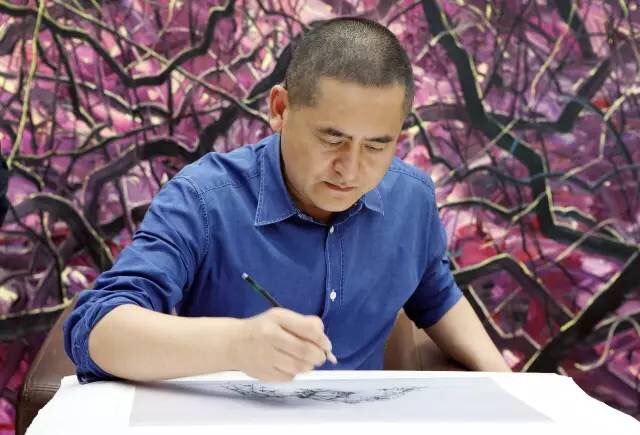
Zeng Fanzhi and his works on paper. Courtesy: © Zeng Fanzhi Studio.
YUAN Space [Zeng’s private museum] will be unveiled next year. What are your plans?
Zeng: It’s been my long-time dream to participate in opening a museum, which seems to me more like an appealing art project that inspires me to create more works. All the details are under preparation, and I cannot speak for the museum before it opens its door.
Why is it a good time for a survey of Zeng’s work?
Tinari: We have been preparing this exhibition for nearly two years, starting from early 2015 when I began to think about this show seriously. Zeng was working on his YUAN Space at that time. He had his own concerns about opening a museum in the future. So it seemed the right time to have a comprehensive survey on his own work in Beijing before his museum opens. After all, an artist is unlikely to give himself an exhibition of his own in a museum of his own founding, you know [laughs].
This interview was originally published in artnet News China. It has been edited and condensed.
“Parcours” is on view at the Ullens Center for Contemporary Art (UCCA) until November 19, in Beijing.